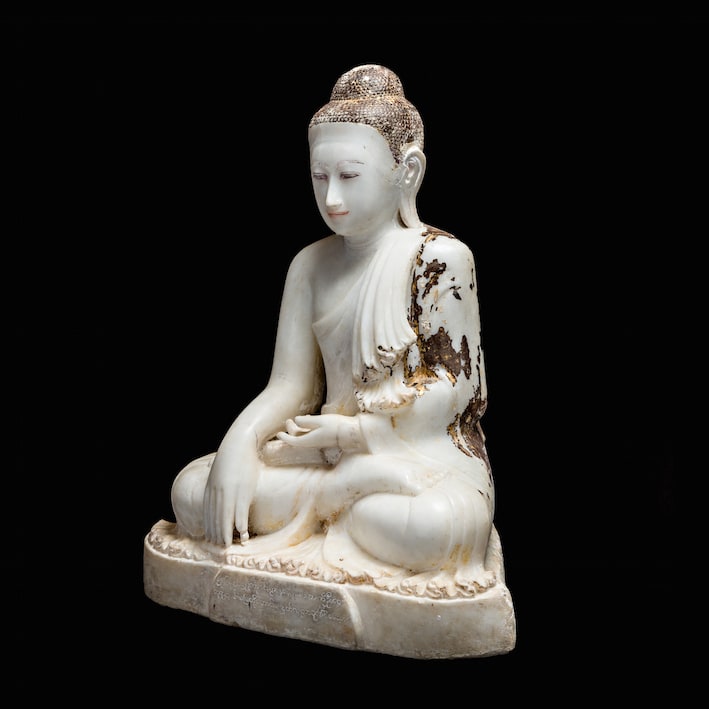Marble Sculpture of the Seated Buddha, 1800 CE - 1900 CE
Marble
85.1 x 65 cm
33 1/2 x 25 5/8 in
33 1/2 x 25 5/8 in
BL.100
Further images
This marble statue of the Buddha demonstrates the high degree of artistic refinement achieved through the artistic expression of religious and philosophical beliefs. In most Asian countries this becomes a...
This marble statue of the Buddha demonstrates the high degree of artistic refinement achieved through the artistic expression of religious and philosophical beliefs. In most Asian countries this becomes a canonical form, which distinguishes the Buddha from all other figures. Cross-legged in yogic posture, the Buddha touches the earth with the tips of his fingers, palm faced downward and arm fully extended-a symbolic gesture summoning the earth goddess to witness his right to sit beneath the tree of wisdom called the Bhumisparsha Mudra. It is the moment of enlightenment, the attainment of Buddha hood in which the transcendence is achieved. The sensation of tranquility and detachment experienced in this stage is evident in the facial features which are further enhanced by the smoothness and clarity of the medium. The Buddha's robe covers the left shoulder in the traditional monastic manner, is pleated at the edges and fans out over the base. All the parts of his body are perfectly proportioned, symmetrical, smooth and fully rounded: the shoulders are broad, and the hips narrow; his arms reach down to the knees and the lobes of his ears are distended. The general appearance associated with the Buddha characterizes him partly as a noble human being and ideal ruler and partly as superhuman. The elegance and spirituality of the Buddha form is well conceived in this Burmese marble representation.
The Shan have inhabited the Shan Plateau and other parts of modern-day Myanmar as far back as the 1200s. They are believed to have migrated from the mountains of Yunnan in China. The Shan are descendants of the oldest branch of the Tai ethnicity, known as Tai Long (Great Tai). Shan who migrated to the south and now inhabit modern-day Laos and Thailand are known as Tai Noi (or Tai Nyai), while those in parts of northern Thailand and Laos are commonly known as Tai Noi (Little Tai - Lao spoken).
The Shan kingdom of Mong Mao existed as early as the 900s, but in the 1000s, the Burmese king Anawrahta of the Pagan kingdom forced it to become a vassal state. However, in 1284, the Mongols, under Kublai Khan pillaged Pagan, and the Shan gained power throughout modern-day Myanmar, expanding as far south as Mawlamyaing, as far west as Rakhine State, and as far east as Assam. This rapid expansion however proved deleterious; territories in Laos and Thailand broke off to form the kingdom of Siam, and constant warfare further weakened the kingdom which ended in 1604 following the death of San Hum Hpa. The Shan States disintegrated into smaller semi-autonomous kingdoms in the Shan Plateau, which were conquered during the reign of another Burmese king Alaungpaya of the Konbaung Dynasty. After the British conquered and annexed Burma during the reign of King Thibaw, the Shan kingdoms were transferred to British control. Under the colonial administration, the Shan principalities were administered separately as British protectorates with limited monarchial powers invested in the Shan Saopha
The Shan have inhabited the Shan Plateau and other parts of modern-day Myanmar as far back as the 1200s. They are believed to have migrated from the mountains of Yunnan in China. The Shan are descendants of the oldest branch of the Tai ethnicity, known as Tai Long (Great Tai). Shan who migrated to the south and now inhabit modern-day Laos and Thailand are known as Tai Noi (or Tai Nyai), while those in parts of northern Thailand and Laos are commonly known as Tai Noi (Little Tai - Lao spoken).
The Shan kingdom of Mong Mao existed as early as the 900s, but in the 1000s, the Burmese king Anawrahta of the Pagan kingdom forced it to become a vassal state. However, in 1284, the Mongols, under Kublai Khan pillaged Pagan, and the Shan gained power throughout modern-day Myanmar, expanding as far south as Mawlamyaing, as far west as Rakhine State, and as far east as Assam. This rapid expansion however proved deleterious; territories in Laos and Thailand broke off to form the kingdom of Siam, and constant warfare further weakened the kingdom which ended in 1604 following the death of San Hum Hpa. The Shan States disintegrated into smaller semi-autonomous kingdoms in the Shan Plateau, which were conquered during the reign of another Burmese king Alaungpaya of the Konbaung Dynasty. After the British conquered and annexed Burma during the reign of King Thibaw, the Shan kingdoms were transferred to British control. Under the colonial administration, the Shan principalities were administered separately as British protectorates with limited monarchial powers invested in the Shan Saopha









